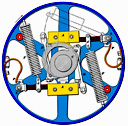
| Project Astro - Astronomy as a learning tool | |||
|
|||
4th grade outline |
|||
Though I have being doing them for several years, in 2009 I finally organized the materials and placed them here for others to use. I'll mark anything added after that with the year added. Some of the activities are labeled "double visit" which generally means an initial longer visit, then a followup visit a week or two later to listen to presentations or whatever the activity needs. This eliminates the pressure to finish everything in the available time and the students can work as a team to develop their materials. Of course this might not be possible for everyone to make that many trips to school so you can rework the activities to have the "start" of a new one be at the end of a previous one, etc. Resist pressure to reduce the time you take. Holding everyone's attention for 90 minutes has never been a problem, and 90 minutes allows some time to go in-depth. I've learned not to underestimate what a 4th grader can comprehend. Visit 1 : Is it Alive? Develop some ideas about what it means to be alive. Activity: determine which sample is alive. Single visit, 90 minutes. Visit 2 : Invent an Alien Based on a randomly determined planet, design an alien that will survive there. Two visits, about an hour each. Visit 3: Moon phases & What is a Theory? In addition to understanding why the moon appears when/where/how it does, we spend some time understanding what a theory is. Two visits, about 90 minutes each. About a month between them so students can actually observe moon phase in the sky. Visit 4: Earth/Moon size Using clay and yarn, develop a model of the Earth/moon system. Math focus. Single visit, 90 minutes. Visit 5: Cook a comet This and the next are the ones that the students seem to remember "years" later. Single visit, 90 minutes. Visit 6: 1000 yard solar system I like this one better than all the others as it really gives a good understanding of the scale of things. Also, where we do this you can see the Sun from Saturn (after which we have to turn a corner) and the impact of that sight is huge. Two visits, about 90 minutes each. First visit is very math focused.
|
|||
| Other info | |||
One of the recurring themes in all of the visits is to build up a good understanding about what a scientific theory is. This is a huge problem in the US, with many people (sadly our politicians seem to be some of the worst offenders; the very people that make public policy have "not a clue") failing to understand this most basic precept. For me, the goal is not so much to teach astronomy but to educate the students as to what science is about, that understanding the world around us is interesting, and that it can be fun. The discussion about theories is limited until the moon phases exercise, which lends itself really well to entire scientific process of observation, making a theory, and testing it. However you can always find a way to work it in to all of the activities, if by no other way than a review. One way to remind them of the "only can prove something false" is to drop something a few times at the start of each activity, to make sure the Theory of Gravity is still correct. Some pictures I've taken over the years CreditsI've tried to make sure I put links to the sources for the materials, but sometimes in editing I lose track of where things come from. Feel free to let me know if a credit is due. Anything I've created you're welcome to use under the:  4th grade Project Astro by Brewster LaMacchia is licensed under a Creative Commons Attribution-Noncommercial-Share Alike 3.0 United States License.
|
|||
|
|||